Have a safe day!
Wednesday, July 24
3:30 p.m.
DIRECTOR'S COFFEE BREAK - 2nd Flr X-Over
4 p.m.
Fermilab Colloquium - One West
Speaker: John Huth, Harvard University
Title: The Lost Art of Finding Our Way
Thursday, July 25
THERE WILL BE NO THEORETICAL PHYSICS SEMINAR TODAY
3:30 p.m.
DIRECTOR'S COFFEE BREAK - 2nd Flr X-Over
Click here for NALCAL,
a weekly calendar with links to additional information.
Ongoing and upcoming conferences at Fermilab
|
|
Wednesday, July 24
- Breakfast: breakfast strata
- Breakfast: ham, egg and cheese English muffin
- Carolina pulled-pork sandwich
- Smart cuisine: herb and lemon fish
- Baja chicken enchilada casserole
- Italian antipasto panini
- Pasta bar
- Vegetarian harvest moon vegetable soup
- Texas-style chili
Wilson Hall Cafe menu |
|
Wednesday, July 24
Lunch
- Bacon cheese stuffed shells
- Field greens with herb vinaigrette
- Fresh fruit plate
Friday, July 26
Dinner
- Cold spicy cucumber avocado soup
- Peruvian-style beef kabobs with grilled onions and zucchini
- Quinoa and grilled-pepper salad
- Lime tart with blueberry sauce
Chez Leon menu
Call x3524 to make your reservation.
|
|
Muon g-2 ring begins three-
night journey to Fermilab
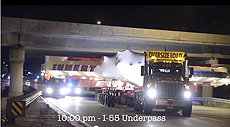 |
On the first of three night journeys on its way to Fermilab, the Muon g-2 ring leaves Lemont, Ill. View the video. On Friday, July 26, at 5:30 p.m., employees, users and the public are invited to celebrate the arrival of the ring on the Fermilab site and watch it go past Wilson Hall in daylight. A group photo with the ring is planned for 7 p.m. Video: Fermilab |
|
Bruce Worthel retires after 30 years at Fermilab
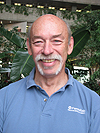 |
|
Bruce Worthel
|
A writer, actor and 3rd dan in kyuki-do, Bruce Worthel is known around Fermilab as a man of many talents. Now Worthel, who has served Fermilab as an electronic technician, operator, crew chief and documentation specialist, will devote more time nurturing his talents outside the laboratory. He retires on July 31 after 30 years at Fermilab.
Worthel began at the laboratory in 1983 as a day worker for a stint that was originally to last only three months. But when the three months were up, he was hired as a day worker again, then rehired as a temporary electronic technician and finally hired for the long haul in the Research Division Operations Department.
As a day worker and an electronic technician, Worthel wired, installed and repaired accelerator instrumentation and equipment and helped bring the Momentum Slit back into operation after years of disuse. As an operator in the Research Division, he helped deliver particle beams to experiments. And as crew chief, he led the team that operated the beamlines.
During that time Worthel began documenting the Operations Department training and procedures, rewriting existing manual text and writing new instructions. Soon after assuming these responsibilities, he returned to school, earning a Bachelor of Arts in writing and language at Aurora University. In 1997, Worthel was promoted to training and documentation specialist, writing and editing documentation for multiple Accelerator Division departments. He also contributed to Fermilab Today, writing articles and the Accelerator Update column, which first ran in 2000.
After retiring, Worthel will devote more time to writing fiction and plays. One of his plays recently won a competition at the Stage Coach Theatre in Dekalb and may end up on the stage next year. He'll continue acting in theaters in and around Chicago and acting as factotum at home.
"I have lots of projects around my house that I want to start—and even finish," Worthel said. "I love to play in the garden. My wife Barbara and I will take a few more trips to see places we haven't seen and to visit with friends and family."
The Accelerator Division will host a retirement party for Worthel on Friday, July 26, at 11:30 a.m. To attend, please RSVP to Dan Johnson, x2074, or to Duane Newhart, x6378, by Thursday afternoon.
|
Ben Freemire
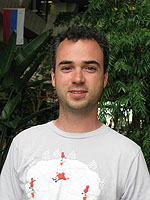 |
Ben Freemire works on radio-frequency cavity R&D for the Muon Accelerator Program. |
NAME:
Ben Freemire
WHICH UNIVERSITY DID YOU ATTEND?
Illinois Institute of Technology
WHAT EXPERIMENT ARE YOU ON?
Radio-frequency cavity R&D at the MuCool Test Area
WHAT IS YOUR RESEARCH FOCUS?
I am currently involved in mitigating RF breakdown in strong external magnetic fields, specifically applied to a muon accelerator cooling channel. The muon accelerator model uses normal-conducting cavities, and I have focused on high-pressure gas-filled cavity tests. However, vacuum cavities with varying material end-plates are also being considered.
HOW DID YOU GET INVOLVED IN PARTICLE PHYSICS?
In two words: Star Trek. I have always been interested in how and why things work, which leads naturally to particle physics. Accelerators play a very important role in this field.
WHERE DO YOU SEE YOURSELF IN FIVE OR 10 YEARS?
I would like to be a scientist at a national lab.
DURING GRAD SCHOOL, WHAT WAS THE MOST UNUSUAL OR EXCITING THING YOU DID OUTSIDE OF PHYSICS?
The most exciting thing by far was getting married. The most unusual, for me, is probably learning to ice skate, which has been a most humbling experience.
WHAT ARE YOU GOING TO DO NOW?
I am continuing RF R&D work as a postdoc while looking for postdoc positions that would keep me in the Chicago area.
WHO WAS YOUR ADVISOR?
Yagmur Torun and Dan Kaplan.
|
Accelerator update, July 19, 2013
General:
Operators continued to clear ground faults, run power supplies and conduct vacuum checks to prepare the Main Injector for proton beam. Linac and Booster had beam over the weekend.
Highlights of completed Main Injector and Accelerator and NuMI Upgrade work.
Removed from the Main Injector all of the antiproton equipment, which came to around 1,800 feet of beamline components.
Pulled more than 1.3 million feet of cable to support the new transfer lines and instrumentation upgrades.
Installed new transfer lines: a new injection line into the Recycler and a new transfer line out of the Recycler ring into the Main Injector.
Moved approximately 590 tons of material, including shielding walls, magnets and stands.
Reused about 70 percent of the instrumentation, roughly 30 percent of the vacuum components and about 85 percent of the magnets.
Installed in the Recycler a new 53-MHz RF cavity system, including two new RF cavities, with a placeholder for the third. Relocated and repurposed the three existing Recycler wideband RF cavities into a damper system.
Worked the Recycler abort system to allow full-turn proton aborts along with gap clearing.
Reworked the Recycler RR30 straight, which involved removing 45 quadrupoles and removing and reworking approximately 900 feet of beam pipe.
Prepped a new insert for the 2.5-MHz RF cavity system for installation in the Recycler 305-306 region.
Relocated sensitive equipment from the MI/RR 30 straight section.
Installed two new 53-MHz cavities in the Main Injector.
View the AD Operations Department schedule.
|
|
Information Resources Department keeps INSPIRE well-oiled
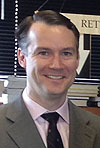 |
|
Heath O'Connell
|
Heath O'Connell, information resources manager in the Information Resources Department, wrote this column.
INSPIRE is the world's key information system for high-energy physics. A central and crucial resource for the particle, astroparticle, nuclear and accelerator physics community, it provides comprehensive databases and associated services covering research, conferences, jobs, experiments, institutions and people in the community. Among other services, INSPIRE generates publication lists, hosts a directory of scientists in the field and provides a place to post and hunt for jobs.
INSPIRE is run by a team of information scientists and software developers from CERN in Switzerland, DESY in Germany, SLAC in California and Fermilab's Information Resources Department (IRD) in the Business Services Section.
One of the Fermilab team's contributions to INSPIRE is in the area of scientific paper authorship. Author disambiguation, in particular, is indispensable to finding all the papers by a particular author and the papers of only that author. Effective disambiguation is also important for the author's citations and impact to be fairly represented. In a community of 18 J. Smiths, 26 C. Chens and 34 J. Kims, that can be a challenging job! INSPIRE has made great strides in automating this disambiguation. In ambiguous and complex cases, algorithms can take you only so far, and human expertise is crucial. IRD staff members are contacted daily by dozens of scientists from around the world who seek to make sure that their publication profiles in INSPIRE are properly curated and that people with similar names are properly sorted. The IRD, together with all partners in INSPIRE and beyond, has now started efforts to address the issue of Asian names, which requires particular care. As part of this effort, the IRD works very closely with Fermilab collaborations upon submission of their articles to make sure every author is properly recognized.
The Fermilab team is also instrumental in INSPIRE's jobs area. The IRD manages the ever-popular INSPIRE jobs database to provide a free and comprehensive place for our community to post and view relevant open positions. Job seekers can sort posts by field, seniority and geographical regions. Roughly 1,000 people subscribe to our courtesy jobs announcement mailing list, and many more browse the site regularly. The IRD staff adds jobs to the database by accepting submissions from users and by scanning the websites of the world's major HEP institutions. In the first half of this year alone, the IRD helped with more than 2,000 queries from users who were adding, removing or updating their postings.
In addition, the IRD ensures all Ph.D. theses based on work done at Fermilab are included in INSPIRE and available to the world as scanned full text. This enables the tracking of theses citations. The IRD also contributes to other community-related activities in INSPIRE, such as improving the way information is presented, scanning old conference proceedings and engaging with the community. As a new activity, the IRD has been helping the CDF and DZero collaborations preserve their notes in INSPIRE.
The worldwide community makes good and frequent use of INSPIRE, and all four managing laboratories work hard to improve the INSPIRE user experience and deliver new services and features requested by the community. We appreciate the strong support of Fermilab's management for INSPIRE as we work to make it an ever more useful service for the scientists of Fermilab and the world.
|
Cables and beamlines and pipes, MI
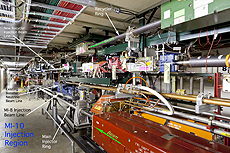 |
The Main Injector is expected to see beam soon. This photo, pointing in the direction the proton beam will travel, shows a particularly crowded section of the Main Injector tunnel.
Photo: Marty Murphy, AD |
|
ESH&Q weekly report,
July 23
This week's safety report, compiled by the Fermilab ESH&Q section, contains four incidents.
An employee misstepped and fell forward, striking his abdomen on a chair and injuring his left knee. This case is not recordable.
An employee's thumb was punctured by a wire when he was tightening it with pliers, breaking the wire. The employee received a prescription for medicine.
While drilling a steel plate, an employee received a steel sliver in his left index finger.
Approximately 1,400 pounds of sulfur hexafluoride were unintentionally released during a gas recovery operation at MI-31. The incident is an ORPS Significance Category 4 event.
Find the full report here. |
Are neutrinos their own antiparticles?
From Science, July 16, 2013
A long-standing controversy among particle physicists looks to be settled—in the less exciting way—thanks to new data from an ultrasensitive particle detector deep underground. Physicists operating the GERmanium Detector Array (GERDA) 1400 meters down in Italy's Gran Sasso National Laboratory say that they see no signs of a hypothesized type of nuclear decay called neutrinoless double-beta decay that, were it conclusively observed, would almost certainly merit a Nobel Prize. The new results stick a pin in a claim made by a rival group in 2001.
Read more |
|